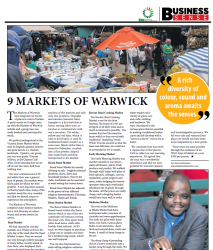9 Markets Of Warwick2019-09-08 The Markets of Warwick have long been on my list of places to visit in Durban. A quick search on Google came up with the Markets of Warwick website and a group tour was easily booked and confirmed by email. We parked underground at the Victoria Street Market which with its brightly-painted exterior and pink turrets is a Durban landmark. Upstairs, our group met our tour guide, Vincent Ndlovu, at the Queens Café. After a brief introduction we set off on our two and a half hour walking tour. Our tour commenced at 9.30 and while there was a general buzz of people, the markets were fairly quiet for which we were grateful. A hot dog seller assured us that by lunch time, many of the markets would be very crowded, and that we should return to experience the atmosphere. The Markets of Warwick comprises nine distinct markets and a rich diversity of colour, sound and aroma awaits the senses. Bead Market We had selected to visit the markets on a Friday as this is the only day of the week that the Bead Market is open. Here we wound our way through orderly passages of many ladies, mostly seated on their floor, who displayed their various beaded items for purchase in front of them. These items range from traditional beaded necklaces to more modern plastic beaded designs. The various items and designs are very appealing as well as inexpensive to purchase. Most of the women's income is obtained from bulk buyers who purchase for resale at more frequented tourist outlets. Impepho and Lime Market The Impepho Market is the smallest of the markets and sells only two products, Impepho and umcako (mineral lime). Impepho is a dry herb that is burnt, among other uses, as incense to communicate with one's ancestors. The white, yellow and red lime, which is sold as dried balls, is used by traditional healers and/or as a sunscreen. Much of the lime is mined in Ndwedwe, crushed into a fine powder, shaped into round balls and then transported to the market. Brook Street Market Brook Street Market has mostly clothing on sale - brightly coloured pinafores, skirts, shirts and household products. Next to the stalls, machinists can be seen hard at work sewing the various items. Brook Street Market lies adjacent to the graves of four different religious denominations: Christian, Muslim, Hindu and Jewish. Berea Station Market The Berea Station Market is found found within the Berea station which is one of the two commuter rail stations serving the inner-city. Here apart from other food items, stalls offer freshly-fried vetkoek. At R3 each, we were happy to purchase a large one to sample and share for a midmorning snack, which was well enjoyed. You can also find numerous stalls selling religious uniforms in the different colours of various Christian orders. Many other stalls trade in a variety of DVDs, shoes, belts, wallets and bags and mixed household items. Music Bridge An important pedestrian link, Music Bridge is named after the loud music and music products for sale in this section of the tour. Bovine Head Cooking Market The Bovine Head Cooking Market is not for the faint hearted. The heads of cows are stripped of all their meat and as much is removed as possible. The women then boil the meat for hours which is then served with traditional 'dumpling' bread. While Vincent assured us that the meat was delicious, we could not be persuaded to try a sample. Early Morning Market The Early Morning Market was another assault on our senses - stalls sell flowers, spices, fresh produce and poultry. We walked through stalls laden with piles of fresh spinach, cabbages, carrots, madumbes, green peppers and more, while dodging the barrow operators who push overloaded wheelbarrows of goods through the aisles. All the prices are really cheap, and a shopping basket would have been well in order. Medicine Market The visit to the Medicine or Muthi Market had been anticipated with a mixture of curiosity and some apprehension. The stalls are piled with dried herbs, tree bark, various plant bulbs, roots and stems, dead birds and animal skins, teeth and bones. A smell of decay hangs in the air. The sharp clang of pounding - that of a heavy metal pole into a bucket rang through the stalls. We watched numerous herb grinders pound tree bark and other items into smaller bits for sale. This was the only market where we were requested not to take photos of the products. Due to the nature of the items being sold, some could be of an illegal nature. Victoria Street Market Our tour ended back at the Victoria Street Market, which is a more formal retail environment where traders sell a variety of spices, arts and crafts, clothing and beadwork. We were introduced to the various spices that are essential to making a traditional Indian curry and left the shop with a "curry in a hurry" mix to try at home. We concluded our tour with a cappuccino at the Queens Café to reflect on our morning experience. All agreed that the tour was a worthwhile experience and that we were grateful for Vincent's patient and knowledgeable presence. We felt very safe and ventured into places we would not have done unaccompanied by a tour guide. These tours are made possible through the assistance of an NGO Asiye eTafuleni at a cost R100 per person. For more information www.marketsofwarwick.co.za |
9 Markets Of Warwick
Copyright © 2024 KwaZulu-Natal Top Business
